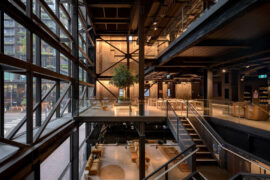To what extent can the workplace be an evolutionary environment? Haworth sees the future of the workspace as ‘organic’ by necessity, and offers a range of capabilities to put flexibility within reach.
The very idea of a flexible real estate strategy is something that seems counter to traditional systems and logic about commercial floor space, or any property for that matter. But in the unpredictable economic environment we are now experiencing, and with business disruptors constantly emerging, it is critical for workplaces to be able to adapt quickly and efficiently to external and internal changes – often far in advance of the expiry of a lease.
Haworth refers to workspaces with this flexible state as ‘organic spaces’. In this era of disruption and an open competitive landscape, companies have to be more agile in their thinking and behaviour, and they have to be able to get the best return-on-investment for their people.
Modular furniture that can be reconfigured has been around for at least 50 years. But today spaces need to respond more immediately than is possible with systems furniture – which is moved at a high cost.
According to Haworth, achieving flexible ‘organic spaces’ requires looking at a client’s real estate holistically across the entire floor plate – not just focusing on the traditional desk areas. Larger proportions of floor plates are shifting from traditional work areas to collaborative areas. “But there are a lot of uncertainties related to collaborative spaces,” suggests Nigel Candasamy, Haworth’s IT/IS and Global Resource Centre Director for Asia Pacific, the Middle East, Latin America and Africa. The settings within these unassigned spaces can serve as important environments for working and collaborating, but they need to align with the processes of how people actually work. “Often people put things in these spaces based on visual decisions, not function,” says Candasamy.
To assist with the development of workplace design strategies, Haworth has developed a proprietary sensor technology that enables the effectiveness of particular settings to be measured and understood – by designers (prior to the implementation of a design), by managers (to survey actual patterns of use) and by workers (who can thus become actively engaged with their workplace scenario). This forms a key part of Haworth’s ‘organic spaces’ approach.
In Haworth’s system, sensors take readings of a space every 15 seconds and the data is fed online where it is sorted in a real-time dashboard. A heat map indicates the areas of a floor plate that are being used. Averages for a specified time period can be generated, and filters can be applied – such as a day of the week or a time of the day. “We’ve had uptake from customers in the use of Haworth’s analytic sensors, and so far we know that occupancy at assigned desks averages around 50 per cent,” says Candasamy. This points clearly to the increase in mobile and e-based working and the importance of unassigned collaborative areas.
“There are many tracking technologies on the market – smartphone apps, card systems and heat systems,” says Candasamy. “We use the latter because it doesn’t allow people to be identified or tracked; a heat reading will only identify whether a space is occupied or not.” He adds, “We want to help our clients keep their floor plate relevant throughout the rental period. This sensor system is a way to prove or disprove workplace strategy. It’s a powerful tool that allows people to measure the success of workplace policies before they make real estate decisions.”
An ‘organic space’ is one that will have a long life and adapt to evolving needs, and as furniture is re-positioned, re-purposed and re-used, it will inevitably incur wear and tear. Haworth’s sees its capacity to act as a master supplier of both standard and custom furniture as a boon in this regard, with its integrated manufacturing and supply capabilities allowing for the ongoing maintenance and potential refurbishment, adaptation and re-use of pieces in changing circumstances. For furniture pieces without a re-use option, Haworth offers assistance to the client with recycling or donation. Certainly, the less material in landfill, the better.
INDESIGN is on instagram
Follow @indesignlive
A searchable and comprehensive guide for specifying leading products and their suppliers
Keep up to date with the latest and greatest from our industry BFF's!

For Aidan Mawhinney, the secret ingredient to Living Edge’s success “comes down to people, product and place.” As the brand celebrates a significant 25-year milestone, it’s that commitment to authentic, sustainable design – and the people behind it all – that continues to anchor its legacy.

The undeniable thread connecting Herman Miller and Knoll’s design legacies across the decades now finds its profound physical embodiment at MillerKnoll’s new Design Yard Archives.

London-based design duo Raw Edges have joined forces with Established & Sons and Tongue & Groove to introduce Wall to Wall – a hand-stained, “living collection” that transforms parquet flooring into a canvas of colour, pattern, and possibility.

Foster + Partners has recently delivered two significant projects in Sydney, working across both commercial and public transport infrastructure.

The workplace strategist and environmental psychologist was in Sydney earlier this year to give a talk at Haworth on the fallacies of the ‘average’ in workplace design.
The internet never sleeps! Here's the stuff you might have missed

Tzannes has completed work at The Brewery in Sydney’s Central Park, marking the culmination of an internationally significant adaptive reuse project.

From Australian architects to Spanish and Indian designers, Design Mumbai 2025 expands its international reach — proving India’s growing role on the global design stage.